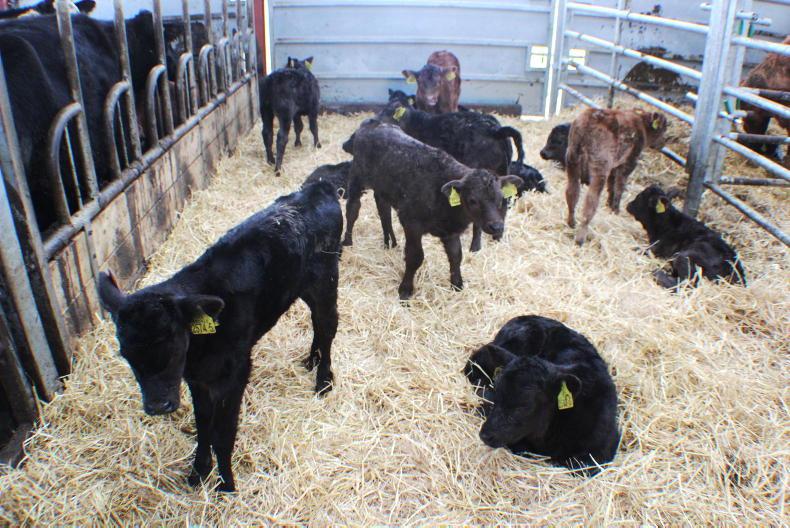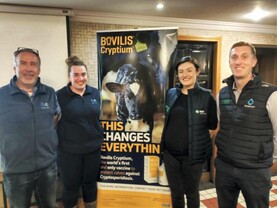On suckler farms calving during February and March, freshly calved cows will most likely remain housed until ground conditions permit cattle getting out to grass.
When newborn calves remain housed after birth, they are more susceptible to scours.
The risk is increased when calves share larger, straw-bedded group pens with cows.
Calf scour is the biggest cause of mortality in the first 28 days of life, so keeping on top of shed hygiene and good herd management go a long way to reducing the risk.
Until cows can get out to grass, outlined are five tips to reducing calf scour in newborn calves this spring.
1 Move cows from calving pens ASAP
If cows calve in individual calving pens, it is important they move to larger, loose pens at the first opportunity.
When cows are left in calving pens for three to four days, they can shed pathogens in faeces, which will be confined to pen.
Remember that these pens are where calves will be born.
Calves are born with zero immunity and will lie with their naval in contact with bedding as soon as they hit the ground.
This increases the chances of a calf picking up an infection before getting its first feed of colostrum.
2 Cleaning out sheds midway through calving
Scours are more common towards the end of the calving period.
This is because the build-up of pathogens in cattle sheds will be greater during the second half of calving.
Cleaning out sheds midway through calving cuts down the build-up of scour pathogens, thereby reducing the risk to animals born in the second half of the calving period.
Realistically, time will be at a premium midway through calving, so washing the shed is unlikely.
Instead, spread hydrated lime before applying fresh straw is recommended.
3 Colostrum
Getting as much colostrum into calves as early as possible is crucial to boosting a newborn’s immune system, especially if you vaccinate against scour.
The calf’s ability to absorb antibodies greatly reduces during the first 12 hours of life, with little or no absorption once the calf is 24 hours old.
Calves should get at least two litres of colostrum in the first two hours of life.
But this is hard to gauge when calves are sucking cows.
Therefore, as a rule of thumb, for every 10-minute period of continuous sucking, the calf should get approximately one litre of colostrum.
4 Clipping cows
As the calf stands and tries to take its first feed, it usually starts sucking on the cow’s hair under the stomach before locating the udder.
If the cow’s hair is heavily soiled from lying on slats, the calf will be sucking faeces that can transmit scour pathogens.
Clipping the part of the cow’s belly next to the udder, as well as the tail, will help keep teats clean and reduce the transmission of scour.
However, clipping of cows should only be carried out if you can safely restrain them.
Use cordless clippers and complete the task in less than two minutes. You only need to remove the worst of the dung.
5 Treating calves and knowing the different scour signs
If you notice a calf with a touch of scour, isolate the animal for treatment.
Do not isolate the animal in pens used for calving.
Keep a close eye on other calves in the group.
If a second calf starts to scour, treat all animals in the group as early as possible, as scour is likely to be working its way through the group.
Make sure affected calves are hydrated. Sick calves will need an oral electrolyte solution, as well as medicine.
When treating scour, it is important to know the cause of the problem.
Calf scour is caused by bacteria (eg E coli), a virus (eg rotavirus) and protozoa (eg crypto) and each needs a different course of treatment, so involve your vet.
Scours caused by rotavirus commonly affect calves around seven to 21 days old and has a watery yellowish/green form of diarrhoea.
Scour caused by E coli usually hits calves in the first few days of life and usually causes yellow/white diarrhoea.
Crypto is more common in calves around 20 to 28 days old and has a yellowish diarrhoea containing mucus.
Read more
Beef management: five tips for resuscitating calves
When to intervene when calving the cow
On suckler farms calving during February and March, freshly calved cows will most likely remain housed until ground conditions permit cattle getting out to grass.
When newborn calves remain housed after birth, they are more susceptible to scours.
The risk is increased when calves share larger, straw-bedded group pens with cows.
Calf scour is the biggest cause of mortality in the first 28 days of life, so keeping on top of shed hygiene and good herd management go a long way to reducing the risk.
Until cows can get out to grass, outlined are five tips to reducing calf scour in newborn calves this spring.
1 Move cows from calving pens ASAP
If cows calve in individual calving pens, it is important they move to larger, loose pens at the first opportunity.
When cows are left in calving pens for three to four days, they can shed pathogens in faeces, which will be confined to pen.
Remember that these pens are where calves will be born.
Calves are born with zero immunity and will lie with their naval in contact with bedding as soon as they hit the ground.
This increases the chances of a calf picking up an infection before getting its first feed of colostrum.
2 Cleaning out sheds midway through calving
Scours are more common towards the end of the calving period.
This is because the build-up of pathogens in cattle sheds will be greater during the second half of calving.
Cleaning out sheds midway through calving cuts down the build-up of scour pathogens, thereby reducing the risk to animals born in the second half of the calving period.
Realistically, time will be at a premium midway through calving, so washing the shed is unlikely.
Instead, spread hydrated lime before applying fresh straw is recommended.
3 Colostrum
Getting as much colostrum into calves as early as possible is crucial to boosting a newborn’s immune system, especially if you vaccinate against scour.
The calf’s ability to absorb antibodies greatly reduces during the first 12 hours of life, with little or no absorption once the calf is 24 hours old.
Calves should get at least two litres of colostrum in the first two hours of life.
But this is hard to gauge when calves are sucking cows.
Therefore, as a rule of thumb, for every 10-minute period of continuous sucking, the calf should get approximately one litre of colostrum.
4 Clipping cows
As the calf stands and tries to take its first feed, it usually starts sucking on the cow’s hair under the stomach before locating the udder.
If the cow’s hair is heavily soiled from lying on slats, the calf will be sucking faeces that can transmit scour pathogens.
Clipping the part of the cow’s belly next to the udder, as well as the tail, will help keep teats clean and reduce the transmission of scour.
However, clipping of cows should only be carried out if you can safely restrain them.
Use cordless clippers and complete the task in less than two minutes. You only need to remove the worst of the dung.
5 Treating calves and knowing the different scour signs
If you notice a calf with a touch of scour, isolate the animal for treatment.
Do not isolate the animal in pens used for calving.
Keep a close eye on other calves in the group.
If a second calf starts to scour, treat all animals in the group as early as possible, as scour is likely to be working its way through the group.
Make sure affected calves are hydrated. Sick calves will need an oral electrolyte solution, as well as medicine.
When treating scour, it is important to know the cause of the problem.
Calf scour is caused by bacteria (eg E coli), a virus (eg rotavirus) and protozoa (eg crypto) and each needs a different course of treatment, so involve your vet.
Scours caused by rotavirus commonly affect calves around seven to 21 days old and has a watery yellowish/green form of diarrhoea.
Scour caused by E coli usually hits calves in the first few days of life and usually causes yellow/white diarrhoea.
Crypto is more common in calves around 20 to 28 days old and has a yellowish diarrhoea containing mucus.
Read more
Beef management: five tips for resuscitating calves
When to intervene when calving the cow






 This is a subscriber-only article
This is a subscriber-only article












SHARING OPTIONS: